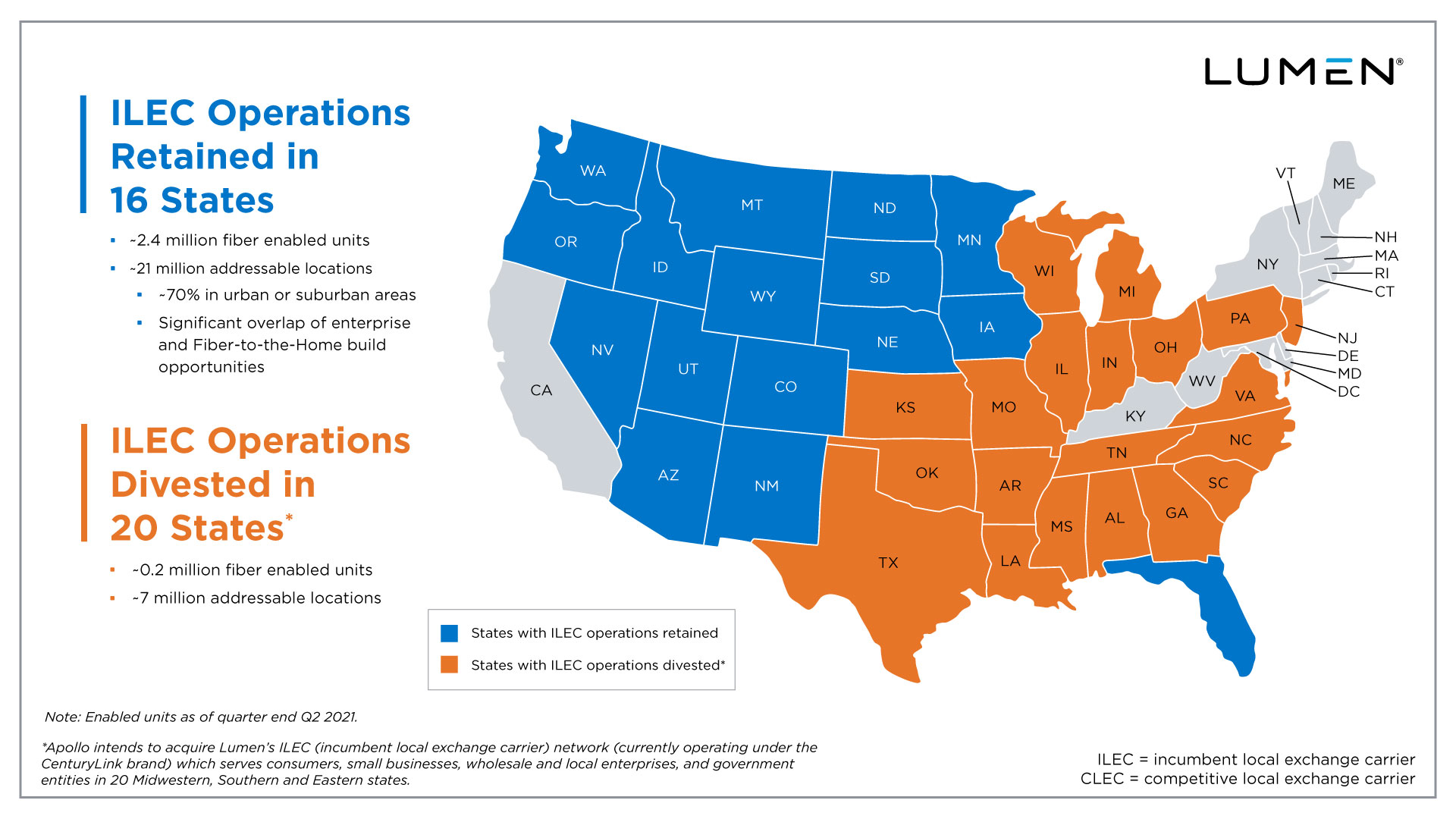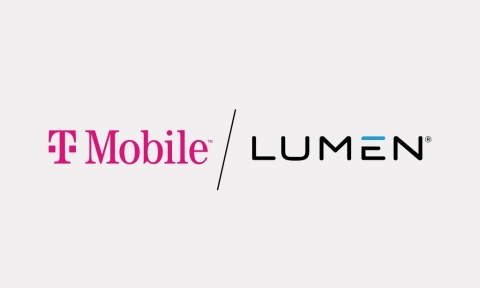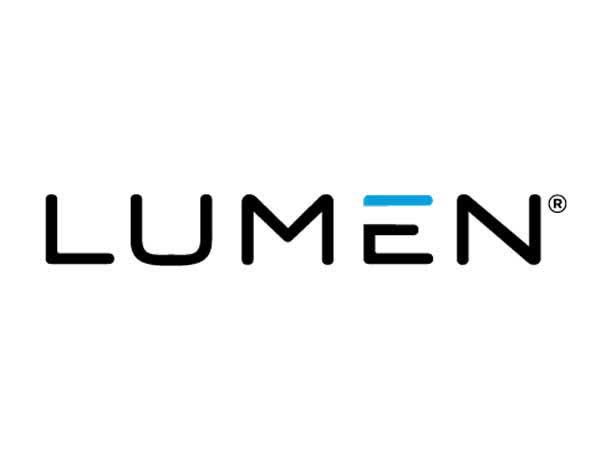Lumen Technologies
Lumen to sell local incumbent carrier operations in 20 states to Apollo Funds for $7.5 billion
Lumen Technologies, formerly known as CenturyLink, has agreed to sell a large part of its U.S. network to Apollo Global Management for $7.5 billion, according to a report by The Wall Street Journal on Tuesday. The report was later confirmed by Lumen.
A collection of telephone lines and broadband infrastructure (which cover 6 million residential and business customers across 20 states, mostly in the U.S. Midwest and Southeast) are included in the deal. So is $1.4 billion of assumed debt by Lumen.
“If you look at the markets that we’re transferring to Apollo, these are markets that Lumen would not have invested as heavily in,” Lumen CEO Jeff Storey said in an interview. “Apollo will put the investment into these markets that we believe they can sustain.”
Lumen’s remaining operations will focus on large business clients, which generate most of its revenue, as well as home-broadband subscribers in 16 states including Colorado, Florida and Washington.
The sale is the latest course change for Lumen, the company known as CenturyLink until its 2020 rebranding. CenturyLink was among the few remnants of the former AT&T monopoly (e.g. US West then Qwest) to survive into the 21st Century, though it avoided copying peers’ pursuit of wireless customers and focused its attention on landlines. In July, Lumen said it was selling its Latin American assets to infrastructure investor Stonepeak Partners LP for $2.7 billion.
CenturyLink grew much bigger after it agreed in 2016 to merge with Level 3 Communications, a network operator focused on large U.S. business customers. The combination yielded billions of dollars in savings and tax advantages, though executives faced challenges stitching together the business cultures of CenturyLink, based in Monroe, LA, and the operations inherited from Level 3 in Broomfield, CO.
For Apollo, the Lumen deal plays into a thesis the firm has developed with the new company’s executives around the need for fiber-based broadband to be expanded in the U.S. While fiber is a superior consumer broadband technology, many potential providers of fiber have lacked the access to capital to upgrade their sprawling networks, according to Aaron Sobel, the Apollo partner who led the deal. As a standalone company, the new entity won’t have other capital needs that take priority.
“It’s very difficult to carve out these states from a large telco,” Mr. Sobel said. “You’re dealing with a business that is legacy and theoretically declining and returning it to growth.”
Lumen is keeping the customers and pieces of its consumer broadband network that seem like a good fit for its fiber business. Everything else it had no plans to invest in is headed to the new company, as it discussed would happen just a few weeks ago.
“We are actively looking at selling non-core assets to unlock value in our business,” Lumen CEO Jeff Storey said during an earnings conference call in May. “If we find transactions that are positive to shareholders, we won’t hesitate to move forward.”
Apollo’s plans aren’t laid out in detail in The WSJ’s article, but it did identify several former Verizon executives who would be leading the new telecom concern absorbing Lumen’s mostly copper-based customers. They include Bob Mudge, Chris Creager and Tom Maguire, a group that helped launch Verizon’s FiOS FTTH service.
Just last week Lumen announced it was selling its Latin American business to Stonepeak, an investment firm, for $2.7 billion. In that transaction, Lumen formed a U.S.-based company that would be in Stonespeak’s portfolio to operate and run its divested network and other assets.

About the Transaction
|
What Does Lumen Retain? |
What Will Apollo Acquire? |
|
21mm Enabled Units |
7mm Enabled Units |
|
2.4mm Fiber Enabled Units |
0.2mm Fiber Enabled Units |
|
3.4mm Broadband Subscribers |
~1.3mm Broadband Subscribers |
|
687k Fiber Subscribers |
59k Fiber Subscribers |
………………………………………………………………………….
MoffetNathanson’s Nick Del Deo, CFA, wrote in a note to clients:
During its Q1 earnings call, Lumen made clear that it was actively looking to optimize its portfolio and was open to asset sales. Moreover, it indicated that share repurchases might be under consideration if the stock price remained at what the company believes to be depressed levels. The company delivered on both fronts.
Last week, Lumen announced it had agreed to sell its Latin American unit to Stonepeak for $2.7B at a ~9x EBITDA multiple.
Not content with one deal, today it announced another to sell about one quarter if its ILEC business to Apollo for $7.5B at a ~5.5x EBITDA headline multiple. And it announced that its Board has approved a $1B share repurchase program that management may use opportunistically over the next two years.
Lumen secured a solid price for the ILEC assets that it is selling to Apollo. However, when considered in tandem with the LatAm deal, they are unlikely to be materially de-levering.
References:
https://news.lumen.com/apollo-transaction-resource-center
Lumen and Microsoft Azure in mutually beneficial partnership
Lumen Technologies, formerly CenturyLink, has identified Microsoft Azure as its preferred public cloud service provider for enterprise customers’ workloads, and will incorporate additional enterprise application capabilities from Azure to Lumen’s wireline telco platform. Microsoft has in turn named Lumen a preferred partner that will support Azure globally via Lumen’s networking, infrastructure and managed services.
Mutual customers will benefit from being able to run their Microsoft-based solutions closer to where digital interactions are occurring using the global Edge Computing services of Lumen, creating one of the fastest, most secure platforms for applications and data.
“Working with Microsoft, Lumen will offer businesses and developers capabilities at the edge that are unique in the industry,” said Shaun Andrews, executive vice president and chief marketing officer for Lumen. “By deeply integrating more of our platform services with Microsoft Azure, we can help businesses quickly utilize their data for the insights they want and need, with the ability to support unique and customized use cases. We’re excited about the innovations and amazing new digital experiences we can enable for our mutual customers by extending Azure to the edge of our global network.”

Lumen will collaborate with Microsoft on several future go-to-market efforts to support mutual customers worldwide, using the resources of the Lumen Edge Experience Center, including:
- A certified Azure deployment which will be able to run in Lumen Edge Computing nodes worldwide, unlocking more low latency and high bandwidth use cases for customers of Azure service platform.
- Communication sector solutions based around Private 5G networks that would leverage the cloud-native software capabilities of Microsoft and the Lumen fiber network and Edge Computing capabilities. These solutions would allow customers to optimize their wireless networks and push workloads even closer to digital interactions.
- Enterprise sector managed solutions for a wide range of Microsoft software and cloud services to help optimize performance of business workloads and support a customer’s entire workforce, wherever they may reside.
“By making Microsoft Azure technology available on the Lumen platform we are giving enterprises access to an environment where they can get the low-latency performance they need for critical applications, with the familiarity of Microsoft services and tools,” said Yousef Khalidi, corporate vice president, Azure for Operators at Microsoft. “With this collaboration we are expanding the ways in which businesses can connect Azure to their enterprise networks and are excited about having Lumen as a collaboration partner to expand the number of use cases we can achieve at the edge of the network.”
Further solidifying their alliance, Lumen has selected Azure as the preferred public cloud venue for workloads that serve its enterprise customers, helping to improve customer experience for the Lumen platform and transforming the ways in which new service features get added to the platform. Enterprise customers will benefit from having consistent access management experiences across all Lumen digital services. Lumen will also leverage Azure, Microsoft Power Apps and Microsoft 365 E5 Security & Compliance for its internal digital transformation.
Additionally, Microsoft has named Lumen as one of its preferred partners supporting Azure globally with Lumen networking, infrastructure, and managed services. Enterprise customers will benefit from having even more high-performing network connectivity to all their Azure services from the Lumen platform.
Lumen’s network includes nearly 450,000 global route miles of fiber and over 180,000 on-net buildings connected to global edge nodes. In addition, Lumen says it has 350 data centers globally, and 2,200 third-party data centers in North America, Europe & Middle East, Latin America and Asia Pacific.
Key Facts:
- Lumen is a certified Microsoft Managed Services Partner for a wide range of Microsoft software and cloud services and Microsoft Gold Partner.
- Lumen edge nodes are designed to meet 95% of U.S. enterprise demand within 5 milliseconds of latency.
- For a current list of live and planned edge locations, visit: https://www.lumen.com/en-us/solutions/edge-computing.html#edge-computing-map
- The Lumen network is comprised of approximately 450,000 global route miles of fiber and more than 180,000 on-net buildings, seamlessly connected to global edge nodes, 350 Lumen data centers globally, and 2,200 third-party data centers in North America, Europe & Middle East, Latin America, and Asia Pacific.

Additional Resources:
For more information on Lumen Edge computing solutions visit: www.lumen.com/edge\
For more information on Azure Stack visit: https://azure.microsoft.com/en-us/overview/azure-stack/
Learn more about Lumen Solutions for Microsoft Teams here: https://www.lumen.com/en-us/communications/ucc.html
About Lumen Technologies:
Lumen is guided by our belief that humanity is at its best when technology advances the way we live and work. With approximately 450,000 route fiber miles and serving customers in more than 60 countries, we deliver the fastest, most secure platform for applications and data to help businesses, government and communities deliver amazing experiences. Learn more about the Lumen network, edge cloud, security, communication and collaboration solutions and our purpose to further human progress through technology at news.lumen.com/home
LinkedIn: /lumentechnologies, Twitter: @lumentechco, Facebook: /lumentechnologies, Instagram: @lumentechnologies and YouTube: /lumentechnologies.
Lumen and Lumen Technologies are registered trademarks in the United States.
…………………………………………………………………………………………………………………………………………………………
References:
https://www.lumen.com/en-us/about/4th-industrial-revolution.html
Lumen Technologies and T-Mobile collaborate on edge compute for enterprise customers
Following this week’s Verizon-AWS announcement on Multi-access Edge Computing (MEC), T-Mobile US has entered the mobile edge computing business using wireline carrier Lumen Technologies (formerly CenturyLink) as its initial preferred vendor.
T-Mobile US has taken a decidedly different MEC approach compared to its two domestic rivals (Verizon and AT&T). The U.S.’s #2 wireless network operator effectively views the edge as a latter opportunity that doesn’t merit a large initial investment. Its edge computing initiatives are exclusively focused on businesses and government agencies that fall under Lumen’s enterprise unit and T-Mobile for business.
“By pairing America’s largest and fastest 5G network with Lumen’s enterprise solutions, we can break down industry barriers and deliver unparalleled network reach to enterprise and government organizations looking to optimize their applications across networks,” Mike Katz, EVP for T-Mobile for Business, said in a prepared statement. “With our leading 5G network, Lumen and T-Mobile have the opportunity to accelerate business innovation in an era where the network is more critical than ever,” Katz added,

Enterprise applications will likely benefit from Lumen’s hundreds of thousands of fiber connected enterprise locations paired with T-Mobile’s “largest and fastest 5G network.”
“The Lumen platform, with 60 plus planned edge market nodes distributed on our high-capacity global fiber network enables application designs with latency of 5 milliseconds or less between the workload and the endpoint device,” wrote David Shacochis, VP of enterprise technology and field CTO at Lumen.
“Lumen’s fiber reach and edge computing resources can augment business solutions for T-Mobile customers, and private wireless solutions can augment business solutions for Lumen customers,” Shacochis added.
“The companies envision starting with metropolitan areas where they are already well connected, and expanding their joint go-to-market over time,” Shacochis wrote, adding that more details about commercial availability and services will be shared throughout 2021.
These efforts aim to address the pressing needs of enterprises to transform their networks to meet the data-intensive challenges across a variety of industries and use cases. Both companies will also continue to drive innovation in this space through T-Mobile’s labs and Tech Experience Center and the Lumen Edge Experience Center.
“Our relationship with T-Mobile aims to introduce a powerful trifecta – access to national 5G wireless and fiber connectivity, managed services across a range of technologies and edge computing resources,” said Shaun Andrews, executive vice president and chief marketing officer for Lumen Technologies. “T-Mobile’s expansive 5G footprint coupled with our extensive edge computing platform would provide enterprise developers with the best of both worlds to power the next wave of digital business.”
- For a current list of Lumen live and planned edge locations, visit: https://www.lumen.com/en-us/solutions/edge-computing.html#edge-computing-map
- The Lumen low latency network is comprised of approximately 450,000 global route miles of fiber and more than 180,000 on-net buildings, seamlessly connected to:
- 2,200 public and private third-party data centers in North America, Europe & Middle East, Latin America, and Asia Pacific
- Leading public cloud service providers including Amazon Web Services, Microsoft Azure ExpressRoute & Azure Government, Google Cloud, IBM Cloud and Oracle Cloud
T-Mobile’s partnership with Lumen is likely just the beginning. “As in all things with 5G, I think a lot of our efforts have to be done through partnerships,” said John Saw, EVP of advanced and emerging technologies at T-Mobile. Apparently, the network operator will form partnerships with many of the big vendors in the space, including hyperscalers (Google, Amazon, Microsoft), and other specialized mobile edge computing vendors.
Similarly, Shacochis said Lumen is also “open to and looking at” other partnerships in the wireless space. Lumen executives outlined a plan to offer edge compute services in August 2019. The company deployed its first block of edge nodes and obtained its first customer in Q3-2020, before formally launching its edge platform in December 2020.
Building on cloud partnerships with Microsoft Azure, Google Cloud and Amazon Web Services (AWS), Lumen bolstered its edge capabilities through additional deals with VMware and IBM.
…………………………………………………………………………………………………………………………….
References:
https://www.sdxcentral.com/articles/news/lumen-lands-t-mobiles-first-5g-edge-contract/2021/04/
https://www.fiercetelecom.com/telecom/lumen-strikes-edge-compute-deal-t-mobile
https://www.sdxcentral.com/edge/definitions/multi-access-edge-computing-vendors/
IBM and Verizon Business Collaborate on 5G, Edge Computing and AI Solutions for Enterprise Customers
Lumen Technologies to empower customers to set up the wavelength subnetworks
Ed Morche, president of strategic enterprise and government markets at Lumen Technologies (formerly CenturyLink) was interviewed by Citi’s Mike Rollins at the Citi 2021 Global TMT West Virtual Conference. Mr. Morche said that Lumen will offer a wavelength topology tool in beta over the coming weeks in order to help its enterprise customers work in a more seamless fashion. The company’s top priority was to constantly improve the customer experience for enterprises. The focus on customer experience is part of Lumen’s digital first strategy, which includes customers ordering, operating and interacting with Lumen on their own terms.
“So making sure that our products and capabilities are completely digitally enabled so that our customers externally can choose when and how they interact with us,” said Morche when explaining Lumen’s digital first strategy. “They’re not reliant on human interaction. We’re here for them if they want us to be. But for those customers who are more independent, or want to work different hours, or just want to be on their own, (we’re) ensuring that they can do that in a very seamless way. And then internally, that allows for a lot of bureaucracy and optics to move out of the organization and into more creative roles,” he added.
Lumen launched hyper WAN last year, which allows customers to go online to order SD-WAN and MPLS services at the same time with security, hyper DDoS—which allows customers to either work with Lumen’s SoC or order it online— and dynamic capacity without going through Lumen’s sales team.
“Then what we’ll see coming from us in beta in the next couple of weeks is a wave topology tool, which I’m really excited about,” Morche said. “So we operate, I would say the largest network in the world, but I’ll say it here, it’s one of the largest networks in the world, and wavelength is a huge part of what we provide to our customers. So they might interact with us looking to provide their own diversity. They already have a route from somebody else, (but) they want to purchase diversity from us.”
Morche said normally customers would work directly with Lumen’s sales team and a sales engineer on setting up their wavelength topologies.
“There would be a lot of collaboration back and forth, or they may want to build an entire diverse wavelength backbone on their own,” Morche said. “So we have opened up the fabric of our network so our customers can see all the points that they can set up wavelengths, all the different routes between those points, and where we have capacity.”
“The customer says ‘Yes, that’s what I want,’ and we authorize that. It flows through into delivery and into assurance. So that tool, from the very beginning of customer interaction, collaborating with us using our network, but not necessarily our people, flows all the way through as an ‘as built’ to the very end.”
If a customer loses its diversity, Morche said Lumen automatically creates a trouble ticket and starts working on the problem as it notifies the customer. “That automatic auditing of capability, that intelligent networking, that unearthing of capability and network is so important to improving customer experience,” Morche said. “So that’s really the first thing that we’re focused on.”
……………………………………………………………………………………………………………………………………………………………………………………………………
Chris Wallendal wrote in a Seeking Alpha column: “Lumen is investing in new capabilities and services to target the large client International and Global Accounts Management (“IGAM”) and Enterprise segments with their extensive networks. The Small and Medium Business (“SMB”) segment is challenged for growth by a large portion of legacy voice services, while the wholesale segment is volatile and faces commodity like competitive pressures. The Consumer segment is still working off no longer supported video and legacy wireline services, but its largest revenue comes from broadband services which is showing growth from demand for high bandwidth (>100Mbps) customers.”
References:
https://kvgo.com/citi/lumen-technologies-january-2021
https://www.lumen.com/en-us/home.html
https://seekingalpha.com/article/4396578-shedding-light-on-lumen-technologies


